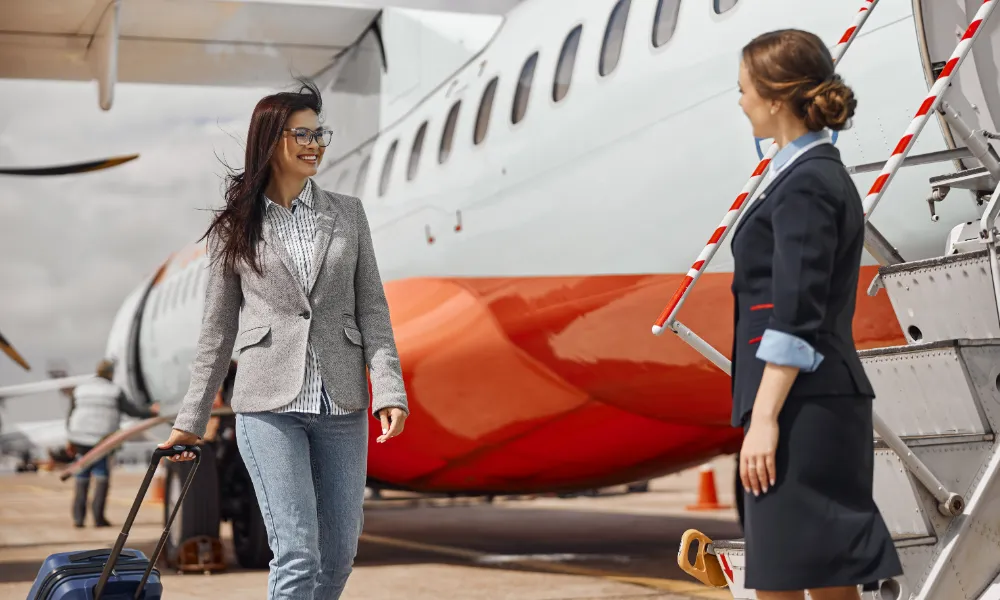
Punta Cana
International Airport
Assistance Services
Jodogo simplifies your Punta cana international airport experience by offering meet-and-greet services, lounge access, and a luxurious limousine for added comfort during your airport transfer. Below are the inclusions covered in our service offerings.
- Meet and Greet at Arrival Gate
- Meet and greet post-immigration
- Wheelchair Assistance
- Porter service
- Assistance at check-in
- Fast Track through immigration
- Priority boarding
- Assistance with baggage handling
- Expedited Service Through Security
- Assistance for terminal transfer
- Escort until car pickup
- Liaise with Driver
- Escort to lounge
- Escort until departure gate
- Buggy Transfer
- Expedited service through Immigration
- Meet and greet at curbside at car drop-off
Punta Cana International Airport (IATA: PUJ, ICAO: MDPC) is a privately owned commercial airport in Punta Cana, eastern Dominican Republic. The airport was built with open-air terminals and roofs covered in palm fronds. Grupo Punta Cana built the airport, which was designed by architect Oscar Imbert, and inaugurated it in December 1983. It is owned by Grupo Punta Cana and became the first privately owned international airport in the world. The airport is the busiest in the Dominican Republic and the second-busiest in the Caribbean.
History of Punta Cana International Airport
The history of aviation in the Punta Cana region started in 1971, when Grupo Puntacana built the first hotel in the area, called "Punta Cana Club", along with a small airstrip. There were no terminals and no runway; it was just a flat piece of land. The only problem was that the area was very secluded from the rest of the Dominican Republic. Also, many more people were starting to go to Punta Cana for vacation, with more and more small cabins being built. Since there were no roads nor harbors, the only way to get into Punta Cana was by air.
In the late 1970s, a road was built to connect the area with the capital of La Altagracia Province, Higüey. Tourists from various countries started to come in. They had to pass through Las Américas International Airport in Santo Domingo, then take a short flight in a small plane to Punta Cana. The airstrip itself had significant problems, such as a very short runway and still no terminal. This meant passengers would exit their plane and be directed onto a road to be picked up to ride to their hotel, which was inconvenient. Grupo PuntaCana knew it needed a real airport.
In late 1974, Grupo Puntacana started to plan the first private international airport. However, the local government disapproved of the new airport. After eight years of arguing with the province, a contract was made to begin construction on the new airport. The airport would be built where the old airstrip stood. In early 1981, planning started on the airport. Oscar Imbert (the son of General Antonio Imbert) was chosen as the architect. He wanted the terminal architecture to be based on Native American Tainos and Arawak structures. At the same time, he wanted to give the passengers a feeling of paradise. The problem was that the planners did not want to pay for expensive air conditioning. The solution to this problem was to build the terminal in such a way that the coastal breezes from the Caribbean Sea would come in and cool down the passengers. The terminal building was planned to have palm fronds for the roof and stone from the nearby jungles for the walls. For the columns, they would use eucalyptus logs and build them in Tano and Arawak styles.
History of Punta Cana International Airport
The history of aviation in the Punta Cana region started in 1971, when Grupo Puntacana built the first hotel in the area, called "Punta Cana Club", along with a small airstrip. There were no terminals and no runway; it was just a flat piece of land. The only problem was that the area was very secluded from the rest of the Dominican Republic. Also, many more people were starting to go to Punta Cana for vacation, with more and more small cabins being built. Since there were no roads nor harbors, the only way to get into Punta Cana was by air.
In the late 1970s, a road was built to connect the area with the capital of La Altagracia Province, Higüey. Tourists from various countries started to come in. They had to pass through Las Américas International Airport in Santo Domingo, then take a short flight in a small plane to Punta Cana. The airstrip itself had significant problems, such as a very short runway and still no terminal. This meant passengers would exit their plane and be directed onto a road to be picked up to ride to their hotel, which was inconvenient. Grupo PuntaCana knew it needed a real airport.
In late 1974, Grupo Puntacana started to plan the first private international airport. However, the local government disapproved of the new airport. After eight years of arguing with the province, a contract was made to begin construction on the new airport. The airport would be built where the old airstrip stood. In early 1981, planning started on the airport. Oscar Imbert (the son of General Antonio Imbert) was chosen as the architect. He wanted the terminal architecture to be based on Native American Tainos and Arawak structures. At the same time, he wanted to give the passengers a feeling of paradise. The problem was that the planners did not want to pay for expensive air conditioning. The solution to this problem was to build the terminal in such a way that the coastal breezes from the Caribbean Sea would come in and cool down the passengers. The terminal building was planned to have palm fronds for the roof and stone from the nearby jungles for the walls. For the columns, they would use eucalyptus logs and build them in Tano and Arawak styles.
Group Transportation Punta Cana International Airport
The airport has five terminals:
International Terminals A and B: international commercial passenger travel
FBO Terminal: executive general aviation
National Terminal: serves national charter and general aviation flights.
VIP Terminal: a private terminal including an aircraft parking apron.
Terminal A, the older of the two international terminals, uses aircraft stairs for passengers to deplane and board aircraft, with access for disabled people using wheelchair lifts. Terminal B was built with seven airbridges, three of which were for wide-body aircraft. This new terminal was completed in 2014 and can comfortably accommodate 6,500 travelers daily and over 2 million travelers annually.

Why should you use JODOGO Airport Assistance?
- Avoid long lines and save time: JODOGO's Meet and Greet services help you bypass long queues at the airport, saving you valuable time and ensuring a seamless travel experience.
- Have a stress-free travel experience: JODOGO’s experienced and professional staff will handle every detail of your airport experience, allowing you to relax and enjoy your journey.
- Get personalized attention: JODOGO’s staff provides personalized attention and assistance, ensuring all your needs are met with care and efficiency.
- Enjoy a variety of services: JODOGO offers a variety of services to meet your needs, including Meet and Greet, porter assistance, fast-track check-in and security, and lounge access.
- Benefit from competitive rates: JODOGO offers competitive rates for its services, making it an affordable option for travelers. Enjoy 24/7 support—JODOGO is always available to assist you with your travel needs.
- Experience a smooth and efficient airport experience: JODOGO's staff is trained to deliver a smooth and efficient airport experience for every traveler.
- Feel confident and secure: JODOGO's knowledgeable and experienced staff ensures you are always in good hands.
- Relax and enjoy your trip: With JODOGO's assistance, you can relax and enjoy your journey, knowing your airport experience is fully taken care of.
FAQs for Airport Assistance
- Visit our website: Go to https://www.jodogoairportassist.com/airports/punta-cana-international-airport.
- Fill out the online form: Provide your flight details, arrival/departure information, and desired services.
- Select your preferred payment method: We accept major credit cards and PayPal.
- Confirm your booking: Upon confirmation, you'll receive an email with all the details.
Yes, we offer VIP concierge services at Punta Cana International Airport to provide a luxurious and personalized experience. Enjoy dedicated assistance with everything from luggage handling and expedited procedures to luxury transportation and personalized airport lounge access.
Additional Services:
- Punta Cana Airport VIP Services
- Punta Cana Airport Fast Track
- Punta Cana Airport Special Assistance
- Punta Cana Airport Private Transfers
- Punta Cana Airport Personal Assistant
Please note: This FAQ content is intended to provide a general overview of our services at Punta Cana Airport. Visit our website for the latest information and specific details regarding our services and pricing.
For more information visit our website: https://www.jodogoairportassist.com/services
Related Airports

Las Américas International Airport (Spanish: Aeropuerto Internacional Las Américas, or AILA) is an international airport located in Punta Caucedo, near Santo Domingo and Boca Chica in the Dominican Republic. The airport is run by Aeropuertos Dominicanos Siglo XXI (AERODOM), a private corporation based in the Dominican Republic, under a 25-year concession to build, operate, and transfer (BOT) six of the country's airports. Las Américas usually receives a wide variety of long-, mid-, and short-haul aircraft. Santo Domingo's other airport, La Isabela, is much smaller and used by light aircraft only.

Samaná El Catey International Airport (IATA: AZS, ICAO: MDCY), also called Aeropuerto Internacional Presidente Juan Bosch (AISA), is an international airport that opened on 6 November 2006, serving the province of Samaná in the Dominican Republic. The airport is located near the village of El Catey, some 8 km (5.0 mi) west of Sánchez, at the base of the mountainous peninsula Cape Samana. Local travel times are given as 30 minutes drive to Las Terrenas, 40 minutes drive to the provincial capital, Santa Barbara de Samaná, and approximately one hour drive to Las Galeras. Samaná El Catey International Airport, also called Aeropuerto Internacional Presidente Juan Bosch (AISA), is an international airport that opened on 6 November 2006, serving the province of Samaná in the Dominican Republic.

Puerto Plata, officially known as San Felipe de Puerto Plata, is the ninth-largest city in the Dominican Republic and the capital of the province of Puerto Plata. The city is a trading port. Puerto Plata has resorts such as Playa Dorada and Costa Dorada, which are located east of the city proper. There are 100,000 hotel beds in the city. Use Wego.co.in to access the greatest selection of flights online. Wego allows you to find the cheapest flights flying from Puerto Plata Airport in San Felipe de Puerto Plata. Use Wego's airport directory to find the cheapest airline tickets from international



